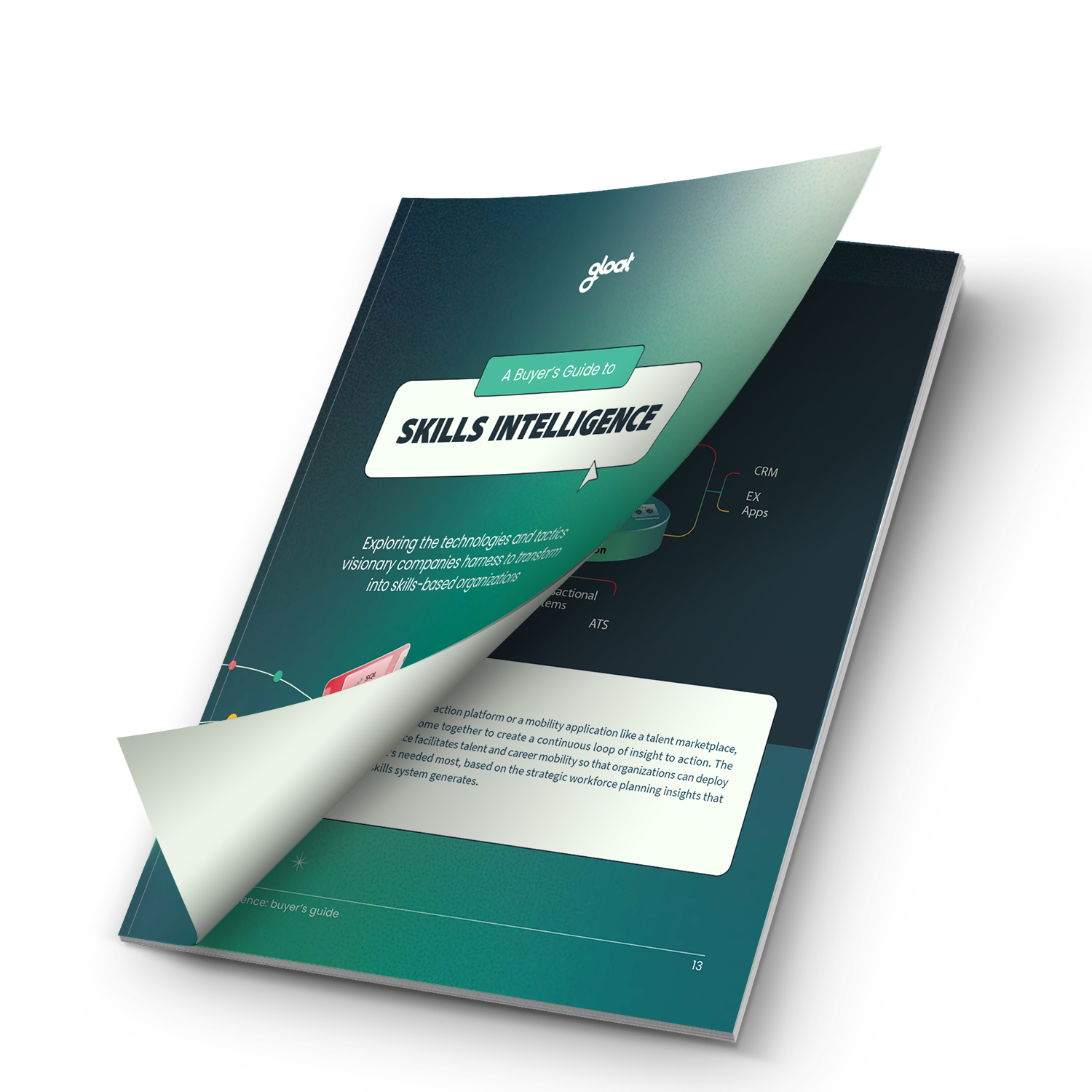How skills intelligence reveals the true value of your workforce
Learn how skills intelligence can impact your organization by providing actionable insights to unlock workforce value As the future of work evolves, skills are emerging as the predominant currency for organizations. With growing talent shortages and skills’ shrinking half-lives, companies are worried they won’t have the capabilities they need. Two thirds of executives acknowledge they

Learn how skills intelligence can impact your organization by providing actionable insights to unlock workforce value
As the future of work evolves, skills are emerging as the predominant currency for organizations. With growing talent shortages and skills’ shrinking half-lives, companies are worried they won’t have the capabilities they need. Two thirds of executives acknowledge they don’t have the skills required to execute critical business initiatives.
With skills quickly rising in the ranks as a C-suite and board-level priority, leaders are embracing new skills-based approaches to their workforce planning and strategy. However, only 6% of organizations have the infrastructure and technology needed to gain real-time skills insights.
Cataloging the skills of an entire workforce and turning the data into actionable insights can be a daunting task, which is why HR teams are harnessing AI-based skills intelligence tools to assist them. From having an updated inventory of their employees’ capabilities to gaining market insights on in-demand skills, these platforms paint a picture of how to upskill and redeploy talent to drive strategic actions.
What is skills intelligence?
Skills intelligence is a technology that helps organizations make data-driven decisions around workforce management and planning. Skills intelligence tools bring all of an organization’s skills data into one place, giving leaders a unified view of what skills exist and where they sit.
A skills intelligence platform can go beyond a skills inventory and harness a self-evolving ontology to reflect the changing relationship between skills, jobs, and employees. These platforms map skills to roles, showcase employees’ skills beyond their job descriptions, and offer insights on potential skill gaps to help leaders finetune their skill-building strategies.
By leveraging skills intelligence, leaders can make informed decisions about hiring, upskilling their workforce, and managing talent effectively. This approach allows organizations to efficiently match people with the right skills to opportunities, which is a key differentiator for Dynamic Organizations today.
Why is skills intelligence important?
Skills intelligence is not only important for HR leaders, but also for the business as well. Finding talent with the right skills and upskilling talent is currently the top priority for C-suite executives. Skills intelligence can help leaders in finding and creating needed skills within their organization to meet critical initiatives.
One way leaders can do this is by leveraging a skills intelligence platform for workforce management. While some tools may only provide a skills taxonomy, a system like Gloat goes beyond that to deliver an ever-evolving skills ontology. This provides a self-updating picture of an organization’s workforce capabilities and how they are changing over time.
With accurate information on what skills sit where, leaders are able to make data-driven decisions regarding where to build, buy, or borrow skills through upskilling, talent acquisition, or contracting and project work. By identifying skill gaps and employees who can easily upskill, businesses can prioritize internal L&D investments and resort to external talent acquisition only for significant gaps. This can help lead to immense cost savings as external hires cost 18% more than internal employees.
Skills can also help to drive business growth. Skills are the crucial building block of the new way of work we find ourselves in. The Josh Bersin Academy has found that companies are more likely to achieve results by shifting to a dynamic way of work. Putting skills, not roles, at the center of work allows for a continuous agile response that can help businesses triple their chances of surpassing their financial targets.
Having visibility into workforce skills also helps future-proof organizations. Companies can see what skill gaps they have and work to close them through upskilling or reskilling. This will not only help develop in-demand skills within the company but also create learning and career opportunities for employees. 86% of CEOs reported that launching training and education programs led to improvements in employee engagement.
Skills intelligence vs traditional HR methods
Traditional HR methods of organizational skills intelligence can be slow, time-consuming, and costly. When HR teams are building out a skills inventory manually they tend to store that information in static programs. Since organizations have hundreds to thousands of skills and roles, this process can be slow, and oftentimes outdated. When tackling this themselves, HR teams may turn to consultants to help speed up the process and free up resources internally. But consultants may not understand the nuance of certain skills or roles within a company. Due to these restrictions, skills insights derived from traditional HR methods tend to be siloed within HR itself, and lack the reach and impact desired on the larger business.
In contrast, skills intelligence platforms are designed to be faster, more accurate, and ever-evolving. They can compile and integrate information from various sources to quickly derive insights into the workforce. Platforms such as Gloat’s Skills Foundation are also constantly updating so that leaders always have the most relevant information. If traditional HR methods are a snapshot into workforce capabilities, then skills intelligence is like a movie. With certainty into the accuracy of the data, HR leaders are better able to speak the language of the business to make data-driven decisions and create a larger impact.
How can I implement skills intelligence into my tech stack?
There are several kinds of skills intelligence solutions across the market to consider. Some vendors in the market provide skills point solutions which are large data sources that are easy to implement and require little change support. While they do have rich information on market data and trends, the downside is they typically lack the nuance to define what skills and jobs mean within a specific organization. Since they don’t have their own interface to manage data, they need to be integrated with other tools in order to create actionable insights and derive the benefits of the data at scale.
Then there are skills solutions built into legacy HR technology systems. While these systems do have an interface to manage data, it is reliant on having up to date information in a human capital management system (HCM). They also prescribe their skills language based around the typical job-based model of work, which limits the ability to harmonize data across systems and provides less nuanced matching as it lacks in-depth intelligence on how skills are evolving.
The next category are full-stack skills systems, like Gloat’s Skills Foundation, which help leaders get the most impact out of skills insights. Full-stack systems are different as they harmonize and normalize skills across multiple systems, serving as a command hub to manage skills and execute actions based on insights. Full-stack systems are built on deep-learning AI and machine-learning capabilities to create a self-updating data layer. These algorithms can help leaders understand the context of roles and skills within their organization gained from internal and external sources. The data is enriched with the ability to manage, map, and view skills, connecting with applications such as a talent marketplace to turn insights into actionable changes.
Benefits of integrating skills intelligence
Having the information skills intelligence provides and implementing its insights can have numerous benefits not only for the business but for employees as well.
For your business
Skills data can help facilitate an agile response to change within an organization. By having visibility into who has what competencies, talent can be quickly redeployed to critical projects. It can also unlock productivity and cost optimization by utilizing internal talent before bringing in contingent labor at a higher rate. Companies can also work to upskill or reskill their workforce to meet future demand for skills, mitigating the risk that they won’t have the competencies needed to drive growth.
For employees
Employees can also benefit from skills-based workforce planning. Instead of looking outside the organization for skills, leaders are better able to address what skills their workforce has so they can develop a clear path to close any knowledge gaps through upskilling and reskilling. This provides employees with the development they crave, and creates lateral or vertical career growth opportunities in the future. 63% of workers cite a lack of growth opportunities as the reason for leaving a job, underscoring the importance of equipping employees with the tools and pathways needed to grow their skills. Lastly, building a skills-based workforce creates more diversified talent pools. Leaders are able to find internal employees with transferable skills that might not have previously been considered, and create a path for them to fill needed roles.
In practice: Using skills intelligence to identify skill gaps in the workforce
A great example of this in action is HSBC, a financial services company headquartered in London. They noticed a growing demand for wealth management services in a specific market, but quickly realized there was little external talent available to fill the amount of roles needed. Rather than hiring externally, they decided to find internal talent with transferable skills and put them in an accelerator program.
HSBC harnessed skills intelligence to have visibility into the capabilities of their employees to align upskilling and reskilling strategies with existing knowledge gaps and future skills needs. They then used the insights from the platform to execute learning opportunities through traditional learning courses, mentorships, projects, and experiential learning experiences.
As employees engaged in development and earned new skills, the platform relayed that information to leaders to inform their workforce planning. Using this method, HSBC efficiently upskilled thousands of employees within one year to satisfy the demand for wealth management roles.
How to implement skills intelligence in the workplace
Embracing skills intelligence in the workplace necessitates a comprehensive mindset shift across the organization. Leaders must recognize the importance of skills over traditional roles and hierarchies, fostering a culture that values continuous learning and development.
Adopting new technology, particularly artificial intelligence, is crucial for implementing skills intelligence. AI can analyze vast amounts of data to identify skill gaps, recommend personalized learning paths, and match employees to projects based on their abilities. Organizations must become comfortable using these tools, thereby enhancing their ability to leverage data-driven insights for better decision-making.
HR must also build a data-driven case to gain buy-in from stakeholders across to business as to why skill intelligence would benefit them. By speaking the language of the business, HR leaders can align their initiatives with organizational goals, highlighting how skills intelligence can improve productivity, innovation, and competitive advantage. Ways to measure this include tracking current skill sets, skills utilization, development progress, and their impact on performance and career progression. Additional metrics to consider include employee engagement, retention, ROI of training programs, and forecasting future skills needs.
One of the best ways to measure skills intelligence’s success is by highlighting the stories that showcase how it’s impacting the business at large. For example, Novartis needed insights into their 105,000 employees and 33,000 job codes to understand their workforce’s current capabilities. They leveraged Gloat’s Skills Foundation to harmonize data across systems and create a unified job architecture to get more quality skills data in two months than in four years of a traditional approach to mapping skills.
Or Standard Chartered Bank who realized 9,000 jobs would become redundant and 14,000 new roles would be required to support the bank’s future. They decided to reskill internal talent via part-time projects, giving employees development and new career opportunities, while saving $49,000 per person that they reskilled.
Seagate also utilized Gloat’s Agile Workforce Operating System to find employees for projects that would have otherwise been staffed by contingent labor. Within 18 months, they were able to staff 58,000 project hours with their own talent. With contingent labor priced at $250/hour, they were able to save $14.5M in costs.
To learn more about skill intelligence platforms, how they can benefit your business, and which one is right for you, check out our Skills intelligence buyer’s guide.





